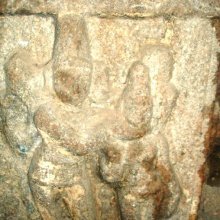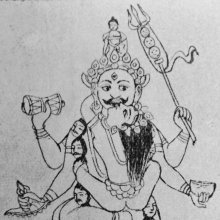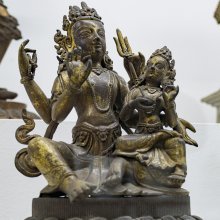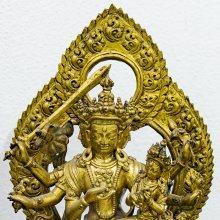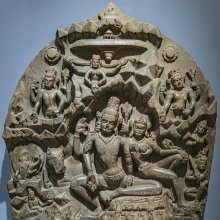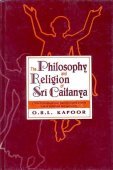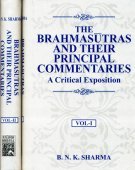Embrace, Embraced, Embracing: 2 definitions
Introduction:
Embrace means something in Hinduism, Sanskrit. If you want to know the exact meaning, history, etymology or English translation of this term then check out the descriptions on this page. Add your comment or reference to a book if you want to contribute to this summary article.
Images (photo gallery)
(+20 more images available)
In Hinduism
Natyashastra (theatrics and dramaturgy)
Source: Shodhganga: Elements of Art and Architecture in the Trtiyakhanda of the Visnudharmottarapurana (natya)Embrace is denoted by the Sanskrit term Utsaṅga, whereas Utsaṅgahasta refers to one of the thirteen Combined-hand Gestures (in Indian Dramas) (known as saṃyuktahastas), according to the Viṣṇudharmottarapurāṇa, an ancient Sanskrit text which (being encyclopedic in nature) deals with a variety of cultural topics such as arts, architecture, music, grammar and astronomy.—According to the Śabdakalpadruma, the word utsaṅga means embrace. In the utsaṅga posture, hands are in arāla position and the palm upwards and overturned and this posture shows the touch of other. In the Abhinayadarpaṇa, the utsaṅga posture is suggested to denote embrace as the word itself means. Moreover this posture is also used to show shame, displaying ornaments, and teaching of boys.

Natyashastra (नाट्यशास्त्र, nāṭyaśāstra) refers to both the ancient Indian tradition (shastra) of performing arts, (natya—theatrics, drama, dance, music), as well as the name of a Sanskrit work dealing with these subjects. It also teaches the rules for composing Dramatic plays (nataka), construction and performance of Theater, and Poetic works (kavya).
Yoga (school of philosophy)
Source: ORA: Amanaska (king of all yogas): A Critical Edition and Annotated Translation by Jason BirchThe Embrace (of amorous women) is denoted by the Sanskrit term Āliṅgita, according to the Amanaska Yoga treatise dealing with meditation, absorption, yogic powers and liberation.—Accordingly, as Īśvara says to Vāmadeva: “[...] [Now], I shall define the nature of that highest, mind-free absorption which arises for those devoted to constant practice. [...] By means of an absorption of eight Palas, the [Yogin’s] sexual desire ceases and it will never arise [again, even] when he is embraced (āliṅgita) by an amorous woman. [...]”.

Yoga is originally considered a branch of Hindu philosophy (astika), but both ancient and modern Yoga combine the physical, mental and spiritual. Yoga teaches various physical techniques also known as āsanas (postures), used for various purposes (eg., meditation, contemplation, relaxation).
See also (Relevant definitions)
Full-text (+1583): Alingana, Parishvanga, Samshlesha, Ankapali, Shlesha, Parirambha, Shlisha, Alingita, Ashlishta, Ashlesha, Kshiranira, Ashrlesha, Lingana, Kanthalagna, Angapali, Ankapalika, Upagudha, Ankolika, Tilatandulaka, Nishangathi.
Relevant text
Search found 318 books and stories containing Embrace, Embraced, Embracing; (plurals include: Embraces, Embraceds, Embracings). You can also click to the full overview containing English textual excerpts. Below are direct links for the most relevant articles:
Bhakti-rasamrta-sindhu (by Śrīla Rūpa Gosvāmī)
Verse 2.4.123 < [Part 4 - Transient Ecstatic Disturbances (vyābhicāri-bhāva)]
Verse 3.5.35 < [Part 5 - Conjugal Love (mādhurya-rasa)]
Verse 3.3.39 < [Part 3 - Fraternal Devotion (sakhya-rasa)]
Mahabharata (English) (by Kisari Mohan Ganguli)
Bhajana-Rahasya (by Srila Bhaktivinoda Thakura Mahasaya)
Text 23 < [Chapter 8 - Aṣṭama-yāma-sādhana (Rātri-līlā–prema-bhajana sambhoga)]
Text 18 < [Chapter 6 - Ṣaṣṭha-yāma-sādhana (Sāyaṃ-kālīya-bhajana–bhāva)]
Text 9 < [Chapter 7 - Saptama-yāma-sādhana (Pradoṣa-kālīya-bhajana–vipralambha-prema)]
Ramayana of Valmiki (by Hari Prasad Shastri)
Chapter 30 - The Death of Khara < [Book 3 - Aranya-kanda]
Chapter 23 - Tara weeps over the Body of Bali < [Book 4 - Kishkindha-kanda]
Chapter 40 - Rama takes leave of the Bears, Monkeys and Titans < [Book 7 - Uttara-kanda]
The Great Chariot (by Longchenpa)
Part 4a.4 - The great mandala of the environment and inhabitants < [B. The explanation of meditation practice]
Part 1 - The brief teaching < [C. The instruction to rely on these holy ones and abandon what is evil]
Part 6 - The divisions of the three inner tantras < [A. Resolving the view]
Related products
(+1 more products available)
